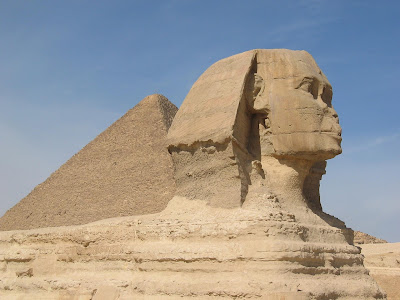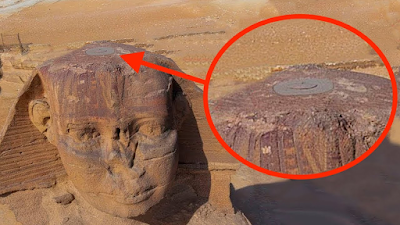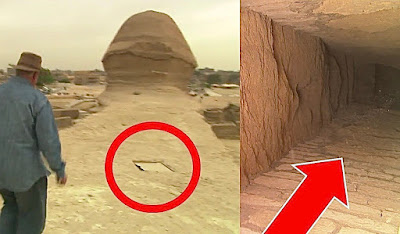The Great Sphinx is considered one of the most remarkable archaeological wonders of the ancient world. It is the largest carved, monolithic statue on Earth, as well as the oldest known monumental sculpture in Egypt. The sphinx is shrouded in mystery to this day, and there is much debate over its age, purpose, and who constructed it. Some believe that there are many secrets hidden underneath the surface, and various entrances lead to a vast subterranean world.
One entrance to the Great Sphinx, a shaft at the back of the monument, was first identified in 1679 by Johan Michael Vansleben and explored in full by Auguste Mariette in 1853. This entrance was sealed off in 1926 by Emile Baraize during restoration work on the Sphinx. Although Mariette saw this opening as a natural fissure, other scholars believe that it may be more than just that. The mysterious tunnel runs through the body of the Sphinx and leads to a void beneath the statue, which may be one of many natural channels that run beneath the Giza plateau's limestone.
Another entrance is located on the top of the head of the Sphinx, and some authors have claimed that this entrance also leads to a subterranean world that has yet to be explored. The head of the Sphinx is said to lead to a smaller chamber in front of the statue. Evidence of these cavities beneath the statue was uncovered in 1987 by a Japanese group of scientists from Waseda University, who conducted an electromagnetic-sounding survey of the Khufu Pyramid and Sphinx.
The existence of these entrances and subterranean spaces is supported by several accounts of explorers throughout history. For example, Charles Thompson, who explored the Sphinx in 1733, spoke of entrances and a "hole in the top of the back" of the Sphinx. Thomas Dobecki and John Anthony used scientific equipment to explore the Sphinx's area and discovered subsurface cavities in front of the sphinx's left paw and the southern flank of the Sphinx.
One of the most famous legends surrounding the Sphinx is the existence of the Hall of Records, a library buried under the Great Sphinx in the Giza pyramid complex. This hall is rumoured to house the knowledge of the ancients in papyrus scrolls, much as the Great Library of Alexandria housed Grecian knowledge. However, there is debate as to whether the famous Hall of Records actually exists.
Some believe that the Sphinx, which sits on the sands of the Giza Plateau in front of the Great Pyramids, could be the gateway to a labyrinth of tunnels and passages and a whole "underground metropolis" that has been lost to the world due to a cover-up by the Egyptian authorities. Malcolm Hutton and Gerry Cannon believe that news of this lost city first hit the headlines due to a Sunday Express article from March 1935 on excavations taking place of an underground city which at the time was said to date back 4,000 years.
Despite various expeditions to explore these subterranean spaces, much of what lies beneath the Great Sphinx is still a mystery. The Sphinx and the Giza plateau are still heavily guarded by the Egyptian authorities, who have prevented further exploration of these areas.
The Great Sphinx of Giza remains an enigmatic and awe-inspiring monument, shrouded in mystery and myth. The possibility of hidden chambers, tunnels, and passages beneath the Sphinx has fascinated researchers, explorers, and historians for centuries. Despite numerous attempts to uncover the secrets of the Sphinx, the exact purpose and origins of this ancient monument remain a mystery. The debate about the existence of the Hall of Records and its contents continues to intrigue scholars and conspiracy theorists alike.
Whether there is a labyrinth of tunnels and a subterranean metropolis hidden beneath the sands of the Giza Plateau remains to be seen. Nevertheless, the Great Sphinx of Giza remains an important symbol of ancient Egyptian civilization, a testament to their ingenuity, and a guardian of the secrets of the ages.
Articles you might like:




Can't we just get the British to go back into Egypt and see what's their?
ReplyDelete"Nevertheless, the Great Sphinx of Giza remains an important symbol of ancient Egyptian civilization, a testament to their ingenuity, and a guardian of the secrets of the ages."
ReplyDeleteIt's the dumbest thing I've heard in a while. As an ancient history page, don't you know that the Sphinx was built over 11 thousand years ago. As a matter of fact, it's so old, that no one knows exactly how old it is
Facts
Delete